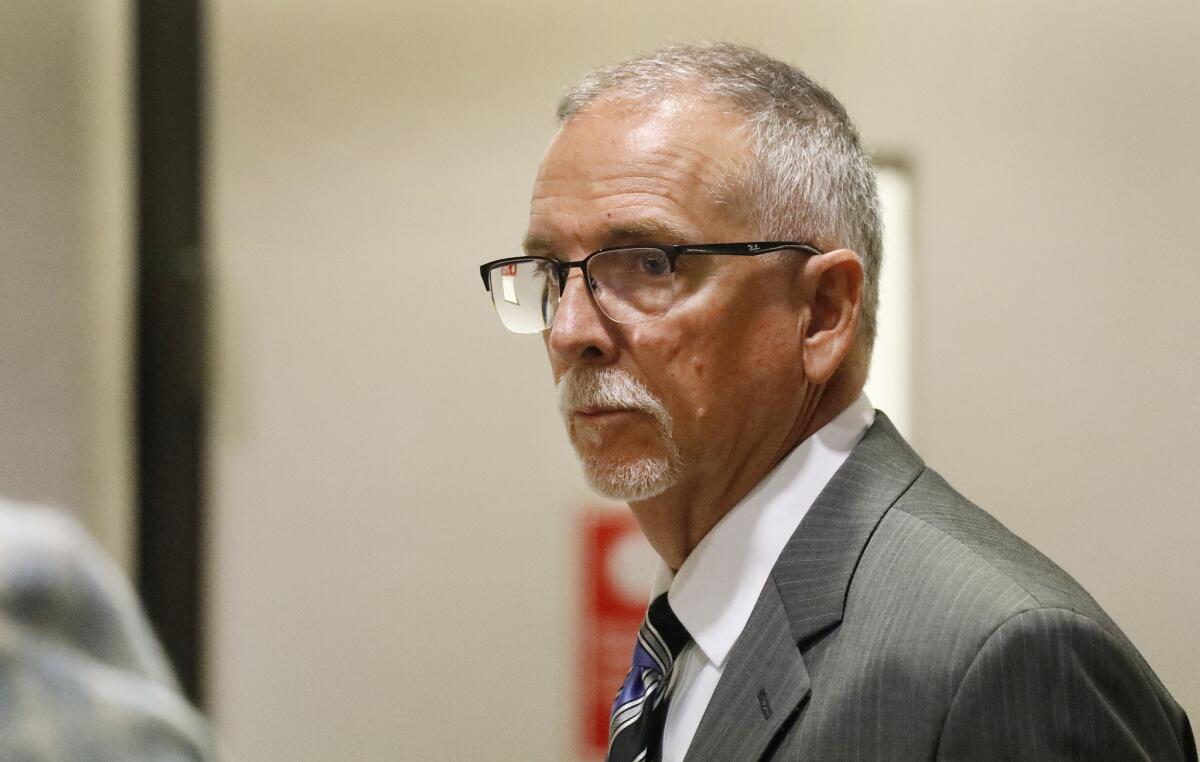Former UCLA Health gynecologist’s behavior with patient constituted sexual assault, report finds

- Share via
The behavior of a prominent UCLA Health gynecologist during an exam with a married mother of four amounted to sexual assault and harassment, according to an investigative report by the university made public Thursday.
It took UCLA almost two years to complete the investigation into allegations raised by a patient against Dr. James Heaps, a 63-year-old physician who was arrested in June on sexual battery and exploitation charges.
The woman saw Heaps in June 2017 to have an intrauterine device, or IUD, removed after she experienced intense uterine cramping shortly after the device was inserted. During the appointment, Heaps allegedly grabbed the woman’s left breast and her buttocks and fondled her clitoral piercing. The doctor’s behavior frightened and alarmed the woman, who was seeing Heaps because her usual gynecologist was unavailable, and she later told her doctor what happened in the appointment, according to the report and interviews with the patient and her attorneys.
A panel of three board-certified physicians and third-party evaluator who reviewed the case were unanimous that Heaps acted inappropriately in touching the woman’s breast and buttocks because she didn’t report pain in either.
They were especially concerned that Heaps touched the piercing for an extended period of time, noting it was “the most alarming conduct that cannot be explained as even remotely appropriate in the context of the problem focused patient encounter,” according to the report.
The Title IX investigation was launched Dec. 22, 2017, and completed Nov. 13 of this year, drawing criticism and questions from both the patient’s and Heaps’ attorneys.
The patient’s attorneys, Jennifer McGrath and Darren Kavinoky, have alleged that Heaps’ celebrity as a high-profile UCLA Health gynecologist whose practice generated millions of dollars to UCLA might have played a role in the way he was treated.
“They say one thing and do another,” Kavinoky said. “UCLA makes promises and assurances to the Los Angeles community that they’re doing the right thing, and in fact what this evidence shows is they attempted to sweep this under the rug and put women in harm’s way while they were doing it.”
Such investigative reports typically take universities no more than a year to complete, a Title IX expert told The Times.
In a statement, UCLA said there were several complicating factors for why the investigation took almost two years to complete — including that this was the first time since Title IX’s inception in 1972 that UCLA conducted such an investigation involving a physician and patient in a clinical setting.
“Second, since Dr. Heaps claimed that his actions were medically appropriate, we had to consult an expert outside medical review team to provide an independent analysis and judgment,” the university’s statement reads.
“The complexity and novelty of the case made the investigation take longer than we would have liked. UCLA seeks to do better and is conducting a thorough review of its policies and procedures related to sexual misconduct in clinical settings. UCLA is also implementing necessary changes across all of its clinical sites to achieve the highest standard of patient care we demand of ourselves.”
Heaps’ attorney Tracy Green said Heaps was interviewed only once for the investigation and that the physicians who reviewed the case weren’t given the medical records from the patient’s appointment. Green said Heaps had anticipated that he would have the opportunity to meet with a panel of physicians and explain his medical approach with the patient.
Green said Heaps checked the patient’s breast to determine whether she had any tenderness caused by the hormones from the IUD and pressed on her backside to check for pain caused by cysts. He checked the piercing to see if it was infected, Green said.
“Dr. Heaps was very proud to be associated with UCLA for his entire career, cared about his patients and would think that a full and fair investigation would be in the best interest of all. Dr. Heaps is dismayed at how this was handled,” Green said in an email. “…If this had been handled in a manner that preserved Dr. Heaps’ due process rights or at least sought his medical clinical input and a full interview regarding his treatment of the patient at issue, it would have been better for all parties.”
Heaps, through his attorneys, has said everything he did was medically appropriate, and his attorneys have said Heaps was a talented physician who saved women’s lives through his work in gynecological oncology.
Federally funded educational programs like UCLA are legally required to launch Title IX investigations when such allegations are made to determine whether a complainant experienced a hostile environment on the basis of sex.
Under UCLA’s policy, its Title IX office “will complete the investigation promptly, typically within 60 to 90 business days of notifying the parties in writing of the charges. However, the Title IX Officer may extend the time frame past 90 days for good cause. The Title IX Officer will notify the parties in writing of the reason for any extension and the projected new timeline.”
Neither Heaps nor the patient were notified of any extensions or a projected timeline, according to their attorneys.
Besides one follow-up interview conducted in March 2018, UCLA conducted all its interviews of the patient, Heaps and UCLA staff for the investigation by Jan. 12, 2018. The university then referred the case to outside medical professionals for review, which UCLA says further delayed the investigation.
The university has declined to answer why Heaps wasn’t placed on leave while the investigation was being conducted. He retired from UCLA in June 2018 and was arrested a year later. Following his arrest, the district attorney asked for a $70,000 bail, and Heaps was released on his own recognizance. No preliminary hearing date has been set.
“An independent committee is examining what occurred and whether our policies and procedures are consistent with best practices and reflect the high standard of patient care we demand of ourselves,” the university said in a statement. “We cannot speak for the committee, but we anticipate that it will make a report to the Regents on its review in the new year and release a public report in 2020.”
Brett Sokolow, president of the Assn. of Title IX Administrators, said the industry standard to complete a Title IX investigation is essentially UCLA’s policy, which gives the university 60 to 90 days, with some ability for extensions when appropriate.
Sometimes investigations take longer, but a potential victim must be provided services and support in the interim while the university completes its report, he said.
Sokolow said UCLA’s approach of only interviewing the patient and Heaps once and not communicating the timeline of the investigation, especially given how long it took, was “odd” and outside industry standards.
“Why on earth wouldn’t they have interviewed her in person? How do you judge someone’s credibly on a street corner over the phone? And industry standard is also to follow up with a secondary interview if not more than one secondary interview,” said Sokolow, who has conducted more than 1,000 investigations. “Typically if we’re interviewing the respondent and witnesses, there’s information those individuals share, and you need to bring it back to the complaining party to get their response.”
Sokolow said it was also surprising Heaps wasn’t placed on some type of leave and instead was allowed to practice for about six months after the patient made her complaint.
“These are fairly significant allegations to not have suspended the respondent pending the investigation,” Sokolow said. “It is also outside the industry norm, especially in a sensitive position where he’s got a lot of patient contact of an intimate nature.”
Since Heaps’ arrest, dozens of former patients have joined civil lawsuits against the physician, alleging that, among other things, he groped their breasts, made crude comments about their bodies, sex lives or the size of their partners’ penises, used the wand during transvaginal ultrasounds in a way that mimicked intercourse, and touched their vaginas in a sexual nature, including stroking their clitorises during annual exams.
Green, Heaps’ attorney, has pointed to the dozens of former patients and colleagues who have written letters of support for Heaps since his arrest.
Heaps worked part time at the UCLA student health center from about 1983 to 2010, was hired by UCLA Health in 2014 and held medical staff privileges at the Ronald Reagan UCLA Medical Center from 1988 to 2018, according to the university.
Last year, Heaps earned more than $1 million, substantially more than the 629 other UC employees in the same job category of Health Sciences Clinical Professor Series. The next highest-paid employee, at UC San Francisco, earned about $477,000. Heaps was listed by the Hollywood Reporter in 2015 as one of the top gynecologists and obstetricians in Los Angeles.
The patient whose complaint started the investigation — and later led to Heaps’ arrest — said in an interview with The Times that UCLA’s handling of the investigation made her feel like they wanted to protect Heaps, not her.
She was surprised a few weeks ago to find the 16-page Title IX investigative review in her mailbox after not hearing from the university after her initial interview in early 2018.
“I respected UCLA — I respected them,” she said. “That’s why I had all my kids there. I wanted to send my kids to UCLA. I wanted to go to UCLA .... I’ve always just loved the Bruins.”
Times staff writer Teresa Watanabe contributed to this report.
More to Read
Sign up for Essential California
The most important California stories and recommendations in your inbox every morning.
You may occasionally receive promotional content from the Los Angeles Times.














